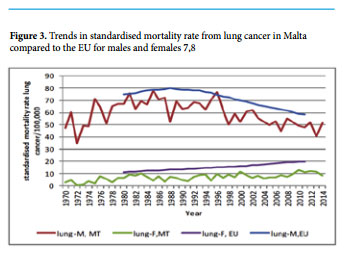Smoking and lung cancer mortality in Malta
Kathleen England
Abstract
In the European region tobacco is responsible for 16% of all deaths in adults and 12% of all deaths in the Maltese population. While locally, fewer adult females smoke when compared to males, there is an increasing trend of smoking amongst females whilst in males we are seeing a decline. Also, while mortality rates in males from lung cancer in Malta are much higher than in females, a downward trend is being observed in males, whilst in females mortality rates are showing a slowly rising trend.
Introduction
Tobacco use or exposure to tobacco smoking has a negative impact on health across the life-course from infancy to old age. The World Health Organisation (WHO) estimates that the global yearly death toll as a result of tobacco use is currently 6 million. Of these, more than 5 million are the result of direct tobacco use while more than 600,000 are the result of non-smokers being exposed to second-hand smoke.1
The regions with the highest proportion of deaths attributable to tobacco are the American and the European regions where tobacco has been used for a longest period of time. According to the WHO Global Report, 25% of adult male deaths and 7% of adult female deaths are attributable to tobacco in the European Region.2
Smoking is a primary cause of preventable illness and premature deaths, being strongly associated with lung cancer, respiratory diseases and heart diseases as well as numerous other cancers
For both males and females, lung cancer is the disease with the largest fraction caused by smoking. Overall 92% of all lung cancer deaths among males and 71% of all lung cancer deaths among females in industrialised countries are attributable to smoking.3
Smoking Behaviour in the Maltese Population
According to the European Health Interview Survey carried out by the Directorate of Health Information and Research in 2008, in persons between the ages of 25-64, 28% of males and 19% of females smoke daily in Malta. In comparison to this, the MONICA project (Multinational monitoring of trends and determinants in Cardiovascular Disease) which was carried out in 1984 reported rates of 47% in males and 14% in females.4 The percentage of smokers categorised by age group and gender are as per figures 1 and 2. These reported proportions are showing that smoking amongst males in the 1980s was very high but has fallen considerably over the past two decades. In contrast, smoking amongst females has always been considerably lower than in males, however we observe an increase from 1984 to 2008.

In adolescents, the European School Survey Project on Alcohol and Drugs study (ESPAD) carried out by SEDQA in 2011, reported that 23% of boys and 20% of girls aged 15-16 years smoked during the 30 days prior to the conduct of the survey. However, there is a falling trend in reported smoking in adolescents since its first report in 1995.5,6
Lung Cancer
Mortality in Malta The different patterns of lung cancer deaths rates in men and women reflect past smoking behaviour. According to the National Mortality Registry within the Directorate of Health Information and Research,7 during 2014 there were 142 deaths in males and 28 deaths in females in Malta from lung cancer, representing 9% of all male deaths and 2% of female deaths. It is the commonest cause of cancer death among both genders combined and among male cancer deaths. As seen in figure 3, mortality rates in males from lung cancer in Malta have been showing decreasing trends from the 1980s, following a similar pattern to the EU average. Mortality rates for females in Malta are much lower than in males and also lower than the EU average, however no similar decline in mortality as observed in males is being seen. On the contrary, there is a slow rising trend in mortality from lung cancer in females in Malta similar to what is seen in the EU. These trends are reflecting the smoking habits being observed in Malta.
International Comparison
In the age groups 20-64 years the EU-25 average (excluding Malta, Cyprus and Croatia) report that 37% of men and 26.9% of women are current smokers. In Malta smoking prevalence for current smokers aged 20-64 was reported at 33.4% for males and 21.5% for females. These reported figures for Malta were the 8th and 7th lowest current smoking prevalence in males and females respectively, among the EU member states.9 Also according to the ESPAD study conducted in 2011 among adolescents (15-16 year olds), comparison of reported cigarette use during the 30 days prior to the study, ranks Malta as 5th lowest in boys and 2nd lowest in girls.6
Similarly, lung cancer mortality rate comparisons between all EU member states report Malta as having the 7th and 3rd lowest lung cancer mortality rates in males and females respectively.

Conclusions
To address the global burden of tobacco, the World Health Assembly in 2003 unanimously adopted the WHO Framework Convention on Tobacco Control. It is a legally binding treaty which binds parties to develop and implement a series of evidence-based tobacco control measures.2 Malta was the second EU Member State after Ireland to prohibit smoking in public places. Locally much has been done to raise awareness regarding the negative consequences of tobacco smoking and smoking cessation initiatives are ongoing. However tobacco smoking is still posing a major burden on Maltese society and much more remains to be done.
The adverse repercussions of tobacco use and exposure extend well beyond the health risks to individuals. For families, communities and government, tobacco use and exposure to second hand smoke represent a significant social and economic handicap, but also importantly constitute a major risk factor in a looming epidemic of non-communicable diseases that threatens to undo many of the global health gains achieved with difficulty over the past 50 years.2

